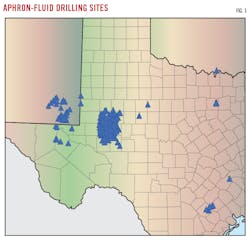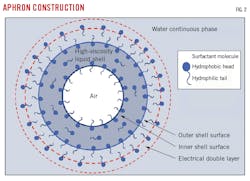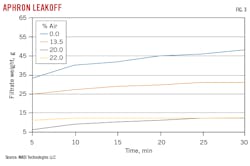Aphron drill-out fluid improves post-frac cleanouts
Occidental Petroleum Corp. successfully performed post-fracturing cleanouts in Midland basin using aphron fluids in depleted reservoirs requiring light fluids with low leakoff properties. Comparison of cleanouts amongst wells using aphrons versus traditional nitrogen showed that wells cleaned-up faster with aphrons. Aphrons also eliminate nitrogen unit costs.
Aphrons
Aphrons (air microbubbles surrounded by a thin surfactant film) have been used in drilling fluids in more than 1,000 wells in Permian and Delaware basins (Fig. 1). They minimize losses while drilling through depleted reservoirs by combining light weight and high low-shear-rate viscosity (LSRV). These qualities make aphrons suitable for post-frac clean-out operations.
Aphrons lighten fluids by incorporating stabilized air microbubbles in water. A protective hydrocarbon surfactant tri-layer surrounds the bubbles and consists of an inner surfactant film enveloped by a viscous water layer (Fig. 2). An outer electrical bilayer provides rigidity and imparts some hydrophilic character to aide dispersion in the aqueous phase to prevent coalescence with nearby aphrons. The shell protects the bubbles from high shear forces, stabilizing the fluid during circulation through the bit or during leakoff in the formation.
Base fluids are fresh water, produced water, or brine. Aphron fluids generally contain 10-20 vol % air, reducing fluid weight by as much as 1.9 lb/gal (ppg) over base weight and lowering equivalent circulation density (ECD).
Aphron have high LSRV due to their stability and act as both a foam and particle during fluid invasion. During overbalanced operations they expand within the pores as they progress from the overbalanced wellbore to the depleted reservoir, increasing pore blockage and minimizing fluid invasion into formations.
Fig. 3 shows leakoff from fluids containing varying concentrations of aphrons passing through a water-filled 70/100 mesh sandpack.1 Aphrons were created with commercial materials including biocide, viscosifier, shale stabilizer, and an aphron generator (surfactant). A tube 2.5 cm in diameter and 91.4 cm in length held the sand pack. Up to 2,500 psi was available from an Isco syringe pump with no backpressure applied. Net leakoff was calculated by subtracting initial pore volume from the total volume of filtrate periodically collected throughout a 30-min test.
Results show that both filtration rate and total leakoff volume decreased as aphron concentrations increased in the base fluid. Maximum leakoff was achieved with 20 vol % air in the mud. Additional air concentration to 22% produced retrograde results, indicating that an ideal aphron concentration exists for a particular leakoff environment.
On location, aphron production requires common drilling fluid mixing equipment and specialized surfactants. Circulation through drillbit nozzles imparts shear to uniformly size and distribute aphrons. Aphron stability is enhanced by viscosifying the base fluid, and common viscosifiers can be used for this application. After shearing, aphrons are generally 15-100 mm in diameter.
Field application
Occidental Petroleum Corp. used aphrons for cleanouts in three wells and compared results with wells cleaned out using conventional nitrogen-lightened fluids (see Table). Lateral lengths ranged from 6,568 ft to 12,600 ft. All wells were cased with 7-in., 32 lb/ft (ppf) P-110 casing to the kickoff point, and 5 ½-in., 20 ppf P-110 casing from kickoff to TD. All wells were cleaned out immediately following fracture stimulation except Well E which was cleaned out 6 months after stimulation.
Polymer and surfactants required to create and stabilize aphrons were blended with fresh water in a pre-mix pit and stored in frac tanks. Transfer pumps were required to provide proper boost to downhole pumps and create an active circulating system between settling tanks and circulation system. Fluid density was checked at the discharge of transfer pumps.
Upon return, the fluid was processed through shale shakers and centrifuged to remove solids. During drill-out, periodic fluid sampling monitored particle size to ensure that solid particles (non-aphron) > 12 mm were removed from the system. At TD, all fluids were displaced with fresh water containing ammonium persulfate to break residual polymer residue in the wellbore.
The aphron fluid was used on a continuous basis between wells and stabilized with daily biocide treatments while being intermittently rolled during storage.
Well D vs. Well C
Well D and Well C were on the same two-well pad, both completed in the Spraberry bench. Well C had 60 stages and Well D had 59 stages. Composite ball frac plugs provided stage isolation and required milling. Final flush after fracturing treatments was with freshwater. Well D initial wellhead pressure was 250 psi upon freshwater circulation. This was 50 psi above static wellhead pressure. Wellhead pressure began dropping at Plug 4 and further decreased as more plugs were milled. Approaching Plug 26, wellhead pressures were 140-200 psi. Returns were lost at Plug 26 whereupon the drillstring stuck. Nitrogen injection began at 1,350 scf/min. Returns were established and the workstring pulled loose. Attempts to continue cleanout without nitrogen caused another drop in wellhead pressure, and nitrogen resumed at 750 scf/min for cleaning out Plugs 33-58.
Well C used the aphron fluid at 7.6 ppg. Static wellhead pressure (WHP) before cleanout was 165 psi. Upon starting cleanout, WHP was about 60 psi. Restricting the choke after cleaning out Plugs 1-13 increased WHP to about 360 psi, which was maintained throughout the cleanout. Mud density maintained 7.2-8.2 ppg throughout the cleanout, with average rates of 4.5 bpm in and 4.4 bpm out. The cleanout had no issues.
Well E vs. Well A
Well E and Well A were in different fields with different lateral lengths, but both were completed in the Spraberry bench. Both wells used composite ball frac plugs for isolation, and both were cleaned out with 25/8-in. coiled tubing (CT). Well E was cleaned out with a nitrogen system and Well A used the aphron system.
Initial nitrogen rate was 750 scf/min which increased to 1,000 scf/min after Plug 13 due to falling WHP. No issues were encountered and plug mill times averaged about 20 min/plug. Sweeps were frequently pumped to clear pipe from debris and sand.
Well A initial aphron system density was 8.1 ppg which dropped to 6.9 ppg during cleanout. Plugs were not encountered during cleanout, but light-to-medium amounts of sand circulated out during the operation. Well E was cleaned out with nitrogen in 3.2 days while the longer Well A was cleaned out with aphrons in 2.6 days.
Well D vs. Well B
Well B contained dissolvable ball drop frac plugs while Well D had composite frac plugs as noted above. Freshwater at 8.3 ppg was left in Well B after fracturing. Initial aphron fluid weight for cleanout was 7.9 ppg. WHP stabilized at about 250 psi after milling the kill plug at 7,106 ft. Pressure decreased during drilling Plugs 1-21. Most dissolvable plugs were not encountered, but a few required 2-4 min milling time. Mud weight decreased from 7.9 ppg to 7.3 ppg between Plugs 1 and 19 but increased to 8.1 ppg after Plug 20 and stabilized at that weight for the remainder of the operation. WHP increased to about 320 psi during cleanout of Plugs 21-43 and stayed there for the remainder of the operation. Rates in and out were stable and all plugs were cleaned out without problem. Dissolvable plugs, combined with the aphron system, resulted in the shortest cleanout time amongst all wells.
Fluid cost
The accompanying table shows the fluid-cost index normalized to the highest total fluid-cost well (Well D). The aphron fluid performed at or below cost of the freshwater-nitrogen fluid, especially in comparison between closely matched Wells C and D. Well A and its companion Well E had similar fluid-cost indices, but Well A had almost twice the lateral length and cleaned up 20% faster than Well E, which is attributable to both aphrons and dissolvable plugs. Comparison of composite-plug Wells C and E showed that the aphron fluid was more efficient in Well C, which was also twice the length of Well E. Ease of use and fluid consistency were added benefits of the aphron system over nitrogen.
Reference
- Growcock, F., “Enhanced Wellbore Stabilization and Reservoir Productivity with Aphron Dilling Fluid Technology,” MASI Technologies LLC, Final Report, Oct. 1- Sept. 30, 2005.
Based on “Utilizing Low-Density Mud Systems to improve Operational Efficiency for Post Frac Cleanout of Unconventional Wells in Depleted Areas,” SPE-209991-MS, SPE Annual Technical Conference and Exhibition, Houston, Tex., Oct. 3-5, 2022.
About the Author
Alex Procyk
Upstream Editor
Alex Procyk is Upstream Editor at Oil & Gas Journal. He has also served as a principal technical professional at Halliburton and as a completion engineer at ConocoPhillips. He holds a BS in chemistry (1987) from Kent State University and a PhD in chemistry (1992) from Carnegie Mellon University. He is a member of the Society of Petroleum Engineers (SPE).




